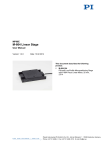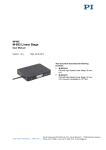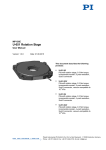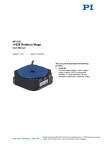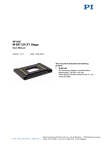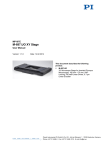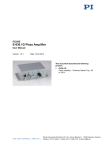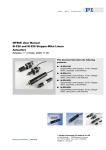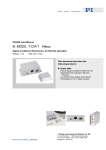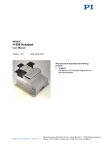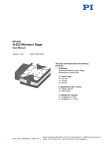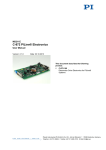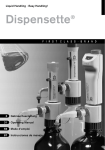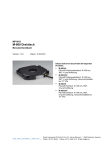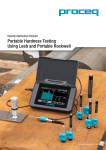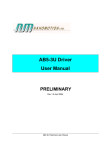Download User Manual MP101E - Physik Instrumente
Transcript
MP101E M-660 Rotation Stage User Manual Version: 1.4.0 Date: 12.02.2014 This document describes the following products: M-660.45 PILine® Precision Rotation Stage, Ø 108 mm, 360°, 4 µrad Resolution M-660.45V PILine® Precision Rotation Stage, Ø 108 mm, 360°, 4 µrad Resolution, -6 Vacuum Compatible to 10 hPa M-660.55 PILine® Rotation Stage, Ø 108 mm, 360º, 34 µrad Resolution M-660.55V PILine® Rotation Stage, Ø 108 mm, 360º, 34 µrad Resolution, Vacuum Compatible to -6 10 hPa Physik Instrumente (PI) GmbH & Co. KG · Auf der Römerstr. 1 76228 Karlsruhe, Germany Phone +49 721 4846-0 · Fax +49 721 4846-1019 · E-mail [email protected] Physik Instrumente (PI) GmbH & Co. KG is the owner of the following trademarks: PI®, PIC®, PICMA®, PILine®, PIFOC®, PiezoWalk®, NEXACT®, NEXLINE®, NanoCube®, NanoAutomation®, Picoactuator®, PInano® PI owns the following patents or patent applications for the technology field Ultrasonic Piezo Motors (PILine®): Germany: DE102004024656A1, DE102004044184B4, DE102004059429B4, DE102005010073A1, DE102005039357B4, DE102005039358A1, DE102006041017B4, DE102008012992A1, DE102008023478A1, DE102008058484A1, DE102010022812A1, DE102010047280A1, DE102010055848, DE102011075985A1, DE102011082200A1, DE102011087542B3, DE102011087542B3, DE102011087801B4, DE102011108175, DE102012201863B3, DE19522072C1, DE19938954A1 Europe: EP0789937B1 EP1210759B1, EP1267425B1, EP1581992B1, EP1656705B1, EP1747594B1, EP1812975B1, EP1861740B1, EP1915787B2, EP1938397B1, EP2095441B1, EP2130236B1, EP2153476B1, EP2164120B1, EP2258004B1, EP2608286A2 USA: US2010/0013353A1, US5872418A, US6765335B2, US6806620B1, US6806620B1, US7218031B2, US7598656B2, US7737605B2, US7795782B2, US7834518B2, US7973451B2, US8253304B2, US8344592B2, US8482185B2 Japan: JP2011514131, JP2011522506, JP3804973B2, JP4377956, JP4435695, JP4477069, JP4598128, JP4617359, JP4620115, JP4648391, JP4860862, JP4914895, JP2013539346 China: ZL200380108542.0, ZL200580015994.3, ZL200580029560.9, ZL200580036995.6, ZL200680007223.4, ZL200680030007.1, ZL200680042853.5 International patent applications: WO2009059939A2, WO2010121594A1, WO2012048691A2, WO2012113394A1, WO2012155903A1, WO2013034146A3, WO2013117189A2 © 2014 Physik Instrumente (PI) GmbH & Co. KG, Karlsruhe, Germany. The text, photographs and drawings in this manual are protected by copyright. With regard thereto, Physik Instrumente (PI) GmbH & Co. KG retains all the rights. Use of said text, photographs and drawings is permitted only in part and only upon citation of the source. Original instructions First printing: 12.02.2014 Document number: MP101E, CBo, version 1.4.0 Subject to change without notice. This manual is superseded by any new release. The latest release is available for download (p. 3) on our website. Contents 1 About this Document 1.1 1.2 1.3 1.4 1.5 1.6 2 3 Goal and Target Audience of this User Manual ...................................................1 Symbols and Typographic Conventions ...............................................................1 Definition ...............................................................................................................2 Figures ..................................................................................................................2 Other Applicable Documents ................................................................................3 Downloading Manuals ..........................................................................................3 Safety 2.1 2.2 2.3 5 Intended Use ........................................................................................................5 General Safety Instructions ..................................................................................5 Organizational Measures ......................................................................................7 Product Description 3.1 3.2 3.3 3.4 3.5 3.6 3.7 1 9 Model Overview ....................................................................................................9 Product View.......................................................................................................10 Product Labeling .................................................................................................10 Scope of Delivery ...............................................................................................12 Suitable Controllers ............................................................................................12 Accessories ........................................................................................................13 Technical Features .............................................................................................13 3.7.1 Rotary Encoder .................................................................................13 3.7.2 Reference Point Switch ....................................................................13 4 Unpacking 15 5 Installation 17 5.1 5.2 5.3 5.4 5.5 5.6 6 General Notes on Installation .............................................................................17 Connecting the M-660 to the Protective Earth Conductor ..................................19 Mounting the M-660 on a Surface ......................................................................21 Affixing the Load to the M-660............................................................................23 Connecting the Vacuum Version to the Controller .............................................24 Connecting the Extension Cable ........................................................................26 Start-Up and Operation 6.1 6.2 29 General Notes on Start-Up and Operation .........................................................29 Starting Up the M-660 with the C-867 Controller ...............................................32 7 Maintenance 7.1 7.2 7.3 35 General Notes on Maintenance ..........................................................................35 Performing a Maintenance Run ..........................................................................35 Cleaning the M-660 ............................................................................................36 8 Troubleshooting 37 9 Customer Service 39 10 Technical Data 41 10.1 10.2 10.3 10.4 10.5 Specifications......................................................................................................41 10.1.1 Data Table ........................................................................................41 10.1.2 Reference Point Switch Specifications .............................................42 10.1.3 Maximum Ratings .............................................................................42 10.1.4 Specifications for Vacuum-Compatible Versions .............................43 Ambient Conditions and Classifications .............................................................44 Motor Power .......................................................................................................45 10.3.1 Motor Power and Operating Voltage ................................................45 10.3.2 Velocity and Torque ..........................................................................46 10.3.3 Motor Power and Lifetime .................................................................47 10.3.4 Influence of Downtimes on the Torque .............................................48 Dimensions .........................................................................................................49 Pin Assignment ...................................................................................................50 11 Old Equipment Disposal 53 12 Declaration of Conformity 55 1 About this Document 1 About this Document In this Chapter Goal and Target Audience of this User Manual ............................................................ 1 Symbols and Typographic Conventions ........................................................................ 1 Definition ........................................................................................................................ 2 Figures ........................................................................................................................... 2 Other Applicable Documents ......................................................................................... 3 Downloading Manuals ................................................................................................... 3 1.1 Goal and Target Audience of this User Manual This manual contains information on the intended use of the M-660. It assumes that the reader has a fundamental understanding of basic servo systems as well as motion control concepts and applicable safety procedures. The latest versions of the user manuals are available for download (p. 3) on our website. 1.2 Symbols and Typographic Conventions The following symbols and typographic conventions are used in this user manual: CAUTION Dangerous situation If not avoided, the dangerous situation will result in minor injury. Actions to take to avoid the situation. NOTICE Dangerous situation If not avoided, the dangerous situation will result in damage to the equipment. Actions to take to avoid the situation. M-660 Rotation Stage MP101E Version: 1.4.0 1 1 About this Document INFORMATION Information for easier handling, tricks, tips, etc. Symbol/Label Meaning 1. Action consisting of several steps whose sequential order must be observed 2. Action consisting of one or several steps whose sequential order is irrelevant List item p. 5 Cross-reference to page 5 RS-232 Labeling of an operating element on the product (example: socket of the RS-232 interface) Warning sign on the product which refers to detailed information in this manual. 1.3 Definition Term Explanation Load capacity Maximum load capacity in the vertical direction when the rotation stage is mounted horizontally. The contact point of the load is in the center of the platform. Rotary encoder The rotary encoder is an incremental sensor for capturing changes in position. Signals from the sensor are used for axis position feedback. After switching on the controller a reference point definition must be performed before absolute target positions can be commanded and reached. 1.4 Figures For better understandability, the colors, proportions and degree of detail in illustrations can deviate from the actual circumstances. Photographic illustrations may also differ and must not be seen as guaranteed properties. 2 Version: 1.4.0 MP101E M-660 Rotation Stage 1 About this Document 1.5 Other Applicable Documents The devices and software tools which are mentioned in this documentation are described in their own manuals. Description Document C-867.160 PILine® controller MS185E User Manual C-867.260 PILine® controller MS189E User Manual C-867.OE PILine® controller MS195E User Manual PIMikroMove SM148E Software Manual PILine® stages MP121EK Short Instructions 1.6 Downloading Manuals INFORMATION If a manual is missing on our website or if there are problems in downloading: Contact our customer service department (p. 39). The current versions of the manuals are found on our website. For some products (e.g. Hexapod systems and electronics that are delivered with a CD), access to the manuals is password-protected. The password is stored on the CD. Download freely accessible manuals 1. Open the website http://www.pi-portal.ws. 2. Click Downloads. 3. Click the corresponding category (e.g. M Hexapods / Micropositioning) 4. Click the corresponding product code (e.g. M-660). 5. Click Documents. The available manuals are displayed. 6. Click the desired manual and save it on the hard disk of your PC or on a data storage medium. M-660 Rotation Stage MP101E Version: 1.4.0 3 1 About this Document Download password-protected manuals 1. Carry out steps 1 to 5 of the download process for freely accessible manuals. 2. Insert the product CD in the PC drive. 3. Switch to the Manuals directory on the CD. 4. In the Manuals directory, open the Release News (file including releasenews in the file name). 5. Find the user name and password in the User login for software download section in the Release News. 6. In the User login area on the left margin in the website, enter the user name and the password in the corresponding fields. 7. Click Login. The available manuals are displayed. 8. Click the desired manual and save it on the hard disk of your PC or on a data storage medium. 4 Version: 1.4.0 MP101E M-660 Rotation Stage 2 Safety 2 Safety In this Chapter Intended Use ................................................................................................................. 5 General Safety Instructions ........................................................................................... 5 Organizational Measures............................................................................................... 7 2.1 Intended Use The M-660 is a laboratory device as defined by DIN EN 61010-1. It is intended to be used in interior spaces and in an environment which is free of dirt, oil and lubricants. In accordance with its design and realization, the M-660 is intended for positioning, adjusting and rotation of loads in a rotational axis at different velocities in interval operation. The M-660 is not intended for applications in areas in which a failure would present severe risks to human beings or the environment. The intended use of the M-660 is only possible when completely mounted and connected. The M-660 uses PILine® ultrasonic piezomotors as a drive and must be operated with a suitable controller (p. 12). The controller is not included in the scope of delivery of the M-660. 2.2 General Safety Instructions The M-660 is built according to state-of-the-art technology and recognized safety standards. Improper use can result in personal injury and/or damage to the M-660. Only use the M-660 for its intended purpose, and only use it if it is in a good working order. Read the user manual. Immediately eliminate any faults and malfunctions that are likely to affect safety. The operator is responsible for the correct installation and operation of the M-660. M-660 Rotation Stage MP101E Version: 1.4.0 5 2 Safety Piezomotors are driven by piezo actuators. After being disconnected from the electronics, piezo actuators can stay electrically charged for several hours. Temperature changes can also induce charges in piezo actuators. Touching charged parts of the M-660 can cause slight injuries from electric shock. Do not open the M-660. Do not touch the contacts in the connector of the M-660. If a protective earth conductor is not or not properly connected, dangerous touch voltages can occur on the M-660 in the case of malfunction or failure of the system. If touch voltages exist, touching the M-660 can result in minor injuries from electric shock. Connect the M-660 to a protective earth conductor (p. 19) before start-up. Do not remove the protective earth conductor during operation. If the protective earth conductor has to be removed temporarily (e. g. in the case of modifications), reconnect the M-660 to the protective earth conductor before starting it up again. Mechanical forces can damage or misalign the M-660. Avoid impacts that affect the M-660. Do not drop the M-660. Do not exceed the maximum permissible stress and load capacities according to the specifications (p. 41). 6 Version: 1.4.0 MP101E M-660 Rotation Stage 2 Safety 2.3 Organizational Measures User manual Always keep this user manual available by the M-660. The latest versions of the user manuals are available for download (p. 3) on our website. Add all information given by the manufacturer to the user manual, for example supplements or Technical Notes. If you pass the M-660 on to other users, also turn over this user manual as well as other relevant information provided by the manufacturer. Only use the device on the basis of the complete user manual. Missing information due to an incomplete user manual can result in minor injury and property damage. Only install and operate the M-660 after having read and understood this user manual. Personnel qualification The M-660 may only be installed, started up, operated, maintained and cleaned by authorized and appropriately qualified personnel. M-660 Rotation Stage MP101E Version: 1.4.0 7 3 Product Description 3 Product Description In this Chapter Model Overview ............................................................................................................. 9 Product View ............................................................................................................... 10 Product Labeling .......................................................................................................... 10 Scope of Delivery ........................................................................................................ 12 Suitable Controllers ..................................................................................................... 12 Accessories ................................................................................................................. 13 Technical Features ...................................................................................................... 13 3.1 Model Overview The M-660 is available in the following versions: Model Description M-660.45 PILine® precision rotation stage, Ø 108 mm, 360°, 4 µrad resolution M-660.45V PILine® precision rotation stage, Ø 108 mm, 360°, 4 µrad resolution, -6 vacuum compatible to 10 hPa M-660.55 PILine® rotation stage, Ø 108 mm, 360º, 34 µrad resolution M-660.55V PILine® rotation stage, Ø 108 mm, 360º, 34 µrad resolution, vacuum -6 compatible to 10 hPa M-660 Rotation Stage MP101E Version: 1.4.0 9 3 Product Description 3.2 Product View Figure 1: M-660 product view 1 Moving platform 2 Base body 3 Cable for connecting to the controller The arrow in the figure shows the positive direction of motion. 3.3 Product Labeling Figure 2: M-660: Position of the product labeling (example view) 10 Version: 1.4.0 MP101E M-660 Rotation Stage 3 Product Description Position Labeling Description A Manufacturer's logo A CE conformity mark A Warning sign "Observe manual!" A M-660.45 Product name (example), the places after the point refer to the model A 113064246 Serial number (example), individual for each M-660 Meaning of the places (counting from left): 1 = internal information 2 and 3 = manufacturing year 4 to 9 = consecutive numbers A WWW.PI.WS Manufacturer's address (website) A Data matrix code (example; contains the serial number) A Old equipment disposal (p. 53) A Country of origin: Germany Country of origin B M-660 Rotation Stage Symbol for the protective earth conductor, marks the protective earth connection of the M-660 MP101E Version: 1.4.0 11 3 Product Description 3.4 Scope of Delivery Item ID Quantit Components y M-660 1 Rotation stage according to order (p. 9) 000036450 1 M4 screw set for protective earth, consisting of: 000029968 1 1 2 safety washers 2 flat washers Screw set for fastening the M-660, consisting of: MP121EK 1 M4x8 flat-head screw with cross recess, ISO 7045 5 M6x12 socket-head cap screws ISO 4762 1 Allen wrench Short instructions for PILine® stages Additional scope of delivery for vacuum versions: C-815.VF K030B0420 1 1 Vacuum feedthrough, Sub-D 15 C815T0003 Technical Note for vacuum feedthrough Extension cable for PILine®, MDR14 to Sub-D 15, 1.5 m 3.5 Suitable Controllers Order Number Description C-867.160 Piezomotor controller / driver, networkable, 1 channel, for PILine® systems C-867.260 Piezomotor controller with drive electronics, 2 channels, for PILine® systems C-867.OE OEM driver / controller card for PILine® ultrasonic motors, 1 channel To order, contact our customer service department (p. 39). 12 Version: 1.4.0 MP101E M-660 Rotation Stage 3 Product Description 3.6 Accessories Order Number Description M-663.AB Adapter box, MDR to 15-pin Sub-D, for PILine® stages with long cables M663T0015 Technical Note for adapter box Extension cables for use with the M-663.AB adapter box: M-663.A01 Extension cable for PILine®, MDR to 15-pin Sub-D, 1 m M-663.A03 Extension cable for PILine®, MDR to 15-pin Sub-D, 3 m M-663.A05 Extension cable for PILine®, MDR to 15-pin Sub-D, 5 m Longer cables available on request. To order, contact our customer service department (p. 39). 3.7 Technical Features 3.7.1 Rotary Encoder The M-660 is equipped with an optical rotary encoder. For the encoder resolution, refer to the table in the "Specifications" section (p. 41). Optical rotary encoders measure the actual position directly (direct metrology). Therefore, errors occurring in the drivetrain, such as nonlinearity, backlash or elastic deformation, cannot influence the measurement of the position. 3.7.2 Reference Point Switch The M-660 rotation stages have an optical reference point switch (see "Reference Point Switch Specifications", p. 42). Used reference point switch type: M-660.45 and M-660.45V: No direction sensing M-660.55 and M-660.55V: Direction-sensing reference point switch See the controller user manual and/or associated software manuals for the commands which make use of the reference point signal. After a reference move of the M-660, the 0° mark on the moving platform is above the reference point switch. M-660 Rotation Stage MP101E Version: 1.4.0 13 4 Unpacking 4 Unpacking INFORMATION When handling the vacuum version of the rotation stage, attention must be paid to appropriate cleanliness. At PI, all parts are cleaned before assembly. During assembly and measurement, powder-free gloves are worn. Afterwards, the rotation stage is cleaned once again by wiping and shrink-wrapped twice in vacuumcompatible film. Only touch the rotation stage with powder-free gloves. If necessary, wipe the rotation stage clean after unpacking. 1. Unpack the M-660 with care. 2. Compare the contents against the items covered by the contract and against the packing list. 3. Inspect the contents for signs of damage. If parts are missing or you notice signs of damage, contact PI immediately. 4. Keep all packaging materials in case the product needs to be returned. M-660 Rotation Stage MP101E Version: 1.4.0 15 5 Installation 5 Installation In this Chapter General Notes on Installation ...................................................................................... 17 Connecting the M-660 to the Protective Earth Conductor ........................................... 19 Mounting the M-660 on a Surface ............................................................................... 21 Affixing the Load to the M-660 .................................................................................... 23 Connecting the Vacuum Version to the Controller ...................................................... 24 Connecting the Extension Cable ................................................................................. 26 5.1 General Notes on Installation CAUTION Dangerous voltage and residual charge on piezo actuators! Piezomotors are driven by piezo actuators. After being disconnected from the electronics, piezo actuators can stay electrically charged for several hours. Temperature changes can also induce charges in piezo actuators. Touching or shortcircuiting the contacts in the connector of the M-660 can lead to minor injuries from electric shock. Do not touch the contacts in the connector of the M-660. NOTICE Lubricants, dirt, condensation! Dirt, oil, lubricants and condensation will render the motor/drive inoperable. Ensure that the piezomotors of the M-660 do not come into contact with lubricants. Keep the M-660 free from dirt and condensation. NOTICE Heating up of the M-660 during operation! The heat produced during operation of the M-660 can affect your application. Install the M-660 so that your application is not affected by the dissipating heat. M-660 Rotation Stage MP101E Version: 1.4.0 17 5 Installation NOTICE Unsuitable cables! Unsuitable cables can cause damage to the controller and can affect the performance of the M-660. Only use original PI parts to connect the M-660 to the controller. If you need longer cables, use the M-663.AB adapter box and an extension cable from PI (p. 26). NOTICE Unintentional changes in position with vertical mounting! If the load exceeds the maximum torque of the drive when the rotation stage is mounted vertically, unintentional changes in the position of the moving platform occur. Unintentional changes in position of the moving platform can damage the drive, the load or the environment. When a rotation stage is mounted vertically, make sure that the installed load is lower than the maximum torque of the drive (p. 41). INFORMATION For the reproducibility of the positioning to be optimal, all components must be affixed with zero-backlash. Make sure that rotation stage and load are affixed with zero-backlash. If possible, perform a simulation of the rotation stage motions with a mounted load or suitable calculations in order to identify collisions or unfavorable center of gravity constellations. If necessary, take suitable constructive measures to avoid collisions and instabilities in the overall system. Avoid or mark danger zones that result from the installation of the rotation stage and the application, in accordance with the legal regulations. For more information about operational conditions, refer to the "Motor Power" section (p. 45). 18 Version: 1.4.0 MP101E M-660 Rotation Stage 5 Installation 5.2 Connecting the M-660 to the Protective Earth Conductor INFORMATION Observe the applicable standards for mounting the protective earth conductor. An M4 hole is located on the M-660 next to the cable exit, for connecting the protective earth conductor. In the following figure, this hole is marked with the symbol for the protective earth conductor . Figure 3: M4 threaded hole for mounting the protective earth conductor Figure 4: Mounting of the protective earth conductor (profile view) 1 Base body of the M-660 2 Flat washer 3 Safety washer 4 Screw 5 Cable lug 6 Protective earth conductor M-660 Rotation Stage MP101E Version: 1.4.0 19 5 Installation Prerequisite You have read and understood the General Notes on Installation (p. 17). The M-660 is not connected to the controller. Tools and accessories Suitable protective earth conductor: Cross-sectional area of the cable 2 ≥0.75 mm Supplied M4 screw set for protective earth (p. 12) for mounting a protective earth conductor Suitable screwdriver Connecting the M-660 to the protective earth conductor 1. If necessary, fasten a suitable cable lug to the protective earth conductor. 2. Fasten the cable lug of the protective earth conductor using the M4 screw on the protective earth connection of the M-660 as shown in the profile view. 3. Tighten the M4 screw with a torque of 1.2 Nm to 1.5 Nm. 4. Make sure that the contact resistance at all connection points relevant for mounting the protective earth conductor is <0.1 Ω at 25 A. 20 Version: 1.4.0 MP101E M-660 Rotation Stage 5 Installation 5.3 Mounting the M-660 on a Surface NOTICE Warping of the base body! Incorrect mounting can warp the base body. Warping of the base body will increase wear and reduce accuracy. Mount the M-660 on an even surface. The recommended evenness of the surface is 10 µm. For applications with great temperature changes: Only fasten the M-660 to surfaces that have the same or similar thermal expansion properties as the M-660 (e.g. surfaces made of aluminum). INFORMATION The positive direction of motion is a clockwise rotation (turn to the right). Figure 5: M-660: Counter-sunk holes in the base body (white arrows = 4 x M6, black arrows = 4 x M4) M-660 Rotation Stage MP101E Version: 1.4.0 21 5 Installation Prerequisite You have read and understood the General Notes on Installation (p. 17). You have provided a suitable surface (for the required position and depth of the holes for accommodating the screws, see "Dimensions", p. 49). Four M6 or M4 holes are present. The evenness of the surface is ≤10 µm. For applications with great temperature changes: The surface should have the same or similar thermal expansion properties as the M-660 (e.g. surface made of aluminum). You accounted for the space required for cable routing free of kinks and in accordance with regulations. The M-660 is not connected to the controller. Tools and accessories Mounting accessories in the scope of delivery (p. 12): 4 M6x12 screws Allen wrench Alternative (not in the scope of delivery): Four M4 screws of suitable length Suitable screwdriver Mounting the M-660 on a surface 1. Align the M-660 on the surface so that the selected holes in the M-660 (see arrows in the figure) overlap with the corresponding holes in the surface. 2. Introduce four suitable screws into the selected counter-sunk holes in the base body of the M-660. 3. Screw in the screws completely. 4. Check that the M-660 fits on the surface without backlash. 22 Version: 1.4.0 MP101E M-660 Rotation Stage 5 Installation 5.4 Affixing the Load to the M-660 NOTICE Impermissibly high forces and torques! Impermissibly high forces and torques that are applied to the moving platform can damage the M-660. For affixing type and mass of the load, observe the maximum permissible forces according to the specifications (p. 41). Avoid tilting torques >0.5Nm at the moving platform. NOTICE Screws that are too long! The M-660 can be damaged by screws that are too long. Note the depth of the mounting holes in the moving platform (p. 49). Only use screws of the correct length for the respective mounting holes. Figure 6: M-660, M3 holes for affixing a load (see arrows) M-660 Rotation Stage MP101E Version: 1.4.0 23 5 Installation Prerequisite You have read and understood the General Notes on Installation (p. 17). You have properly mounted the M-660 on a surface (p. 21). The M-660 is not connected to the controller. You have prepared the load so that it can be affixed to the mounting holes on the moving platform: The distance between the center of gravity of the load and the center of the moving platform is as small as possible in all directions. At least three points are provided for affixing the load on the moving platform. Tools and accessories At least three M3 screws of suitable length (p. 49) Suitable tools for fastening the screws Affixing the load 1. Align the load on the M-660 so that the mounting holes in the load and the holes in the moving platform overlap. 2. Affix the load with at least three screws. 3. Check that the load fits on the moving platform of the M-660 without backlash. 5.5 Connecting the Vacuum Version to the Controller For the vacuum version of the M-660, it is necessary to install a vacuum feedthrough (p. 12). Prerequisites 24 You have read and understood the General Notes on Installation (p. 17). The controller is switched off. You have connected the M-660 to the protective earth conductor (p. 19). You have read and understood the C815T0003 Technical Note for the C-815.VF vacuum feedthrough. Version: 1.4.0 MP101E M-660 Rotation Stage 5 Installation Tools and accessories C-815.VF vacuum feedthrough, Sub-D 15 (p. 12) Suitable tools for installing the vacuum feedthrough K030B0420 extension cable for PILine®, MDR14 to Sub-D 15, 1.5 m, on the air side (p. 12) Installing the vacuum feedthrough 1. Find the dimensions of the vacuum feedthrough in the C815T0003 Technical Note (see "shell size 2"). 2. Provide the vacuum chamber with a suitable opening. 3. Install the vacuum feedthrough so that the Sub-D 15 (f) socket is in the vacuum chamber. Connecting the vacuum version to the controller Connect the M-660 ("stage"), vacuum feedthrough and controller as shown in the connection diagram below. Observe the assignment that is given by the labeling on the sockets, connectors and cables. Figure 7: Connection of the vacuum version to the controller M-660 Rotation Stage MP101E Version: 1.4.0 25 5 Installation 5.6 Connecting the Extension Cable Prerequisites You have read and understood the General Notes on Installation (p. 17). The controller is switched off. You have connected the M-660 to the protective earth conductor (p. 19). For vacuum versions: The C-815.VF vacuum feedthrough is installed (p. 24). Tools and accessories M-663.AB adapter box*, MDR14 to Sub-D 15-pin, for PILine® stages with long cable Extension cable* for PILine®, MDR14 to Sub-D 15-pin, 1 to 5 m, on the air side *Not in the scope of delivery; see "Accessories" (p. 13). Connecting the extension cable Connect the M-660 ("stage") and controller via the adapter box and the extension cable as shown in the respective connection diagram. Observe the assignment that is given by the labeling on the sockets, connectors and cables. Figure 8: Connection of an extension cable to the standard version of the M-660 26 Version: 1.4.0 MP101E M-660 Rotation Stage 5 Installation Figure 9: Connection of an extension cable to the vacuum version of the M-660 M-660 Rotation Stage MP101E Version: 1.4.0 27 6 Start-Up and Operation 6 Start-Up and Operation In this Chapter General Notes on Start-Up and Operation .................................................................. 29 Starting Up the M-660 with the C-867 Controller ........................................................ 32 6.1 General Notes on Start-Up and Operation CAUTION Risk of electric shock if the protective earth conductor is not connected! If a protective earth conductor is not or not properly connected, dangerous touch voltages can occur on the M-660 in the case of malfunction or failure of the system. If touch voltages exist, touching the M-660 can result in minor injuries from electric shock. Connect the M-660 to a protective earth conductor (p. 19) before start-up. Do not remove the protective earth conductor during operation. If the protective earth conductor has to be removed temporarily (e. g. in the case of modifications), reconnect the M-660 to the protective earth conductor before starting it up again. NOTICE Damage if an incorrect controller is connected! Connecting a rotation stage to an unsuitable controller can cause damage to the rotation stage or controller. Only connect a rotation stage with PILine® ultrasonic piezomotors to a PILine® controller (p. 12). M-660 Rotation Stage MP101E Version: 1.4.0 29 6 Start-Up and Operation NOTICE Operating voltage too high or incorrectly connected! Operating voltages that are too high or incorrectly connected can cause damage to the M-660. Only operate the M-660 with controllers/drivers and original accessories from PI. Do not exceed the operating voltage range (p. 42) for which the M-660 is specified. Only operate the M-660 when the operating voltage is properly connected; see "Pin Assignment" (p. 50). NOTICE Unintentional motions! When the M-660 is being connected to the controller, it can carry out unintentional motions. Defective software or wrong operation of the software can also result in unintentional motions. Do not place any objects in areas where they can get caught by moving parts. Before connecting the M-660, check whether a macro is defined as the start-up macro in the controller, and cancel the selection of the start-up macro if necessary. NOTICE Damage from collisions! Collisions can damage the rotation stage, the load to be moved and the environment. 30 Make sure that no collisions are possible between the rotation stage, the load to be moved and the environment in the motion range of the rotation stage. Do not place any objects in areas where they can get caught by moving parts. Stop the motion immediately if a controller malfunction occurs. If possible, adapt the travel range limits of your mechanical system in the software that you use for commanding the motion. Version: 1.4.0 MP101E M-660 Rotation Stage 6 Start-Up and Operation NOTICE Uncontrolled oscillation! Your application can be damaged by uncontrolled oscillation of the M-660. If you encounter noise during operation: Immediately switch off the servo-control system of the affected axes. Check the settings of the servo-control parameters. NOTICE Overheating during continuous operation! The highest dynamic force and holding force are achieved at maximum motor power; however, the M-660 may overheat during continuous operation. Observe the recommended motor power depending on the duty cycle and the ambient temperature (p. 47). NOTICE Damage or considerable wear from high accelerations! High accelerations can cause damage to or considerable wear on the mechanical system. Stop the motion immediately if a controller malfunction occurs. Determine the maximum velocity for your application. Observe the information in the "Motor Power" section (p. 45). INFORMATION Although in theory the M-660 operates quietly, noise levels of up to 50 dB (A) are possible during operation. The ultrasonic drive of the M-660 can also generate higher noise levels at frequencies between 100 and 500 kHz. INFORMATION The positive direction of motion is a clockwise rotation (turn to the right). INFORMATION The repeatability of the positioning is only ensured when the reference point switch is always approached from the same side. Controllers from PI fulfill this requirement as a result of the automatic direction sensing for reference moves to the reference switch. M-660 Rotation Stage MP101E Version: 1.4.0 31 6 Start-Up and Operation INFORMATION For maximum force generation, a run-in procedure is necessary during the start-up of the M-660 and after longer downtimes; see also "Influence of Downtimes on the Torque" (p. 48). After run-in, the M-660 will generate its maximum dynamic force. For run-in, command a few motion cycles at low velocity. The motion cycles should comprise full revolutions if possible. For more information about operational conditions, refer to the "Motor Power" section (p. 45). 6.2 Starting Up the M-660 with the C-867 Controller NOTICE Incorrect parameter settings! When using the software which is included in the scope of delivery of the C-867 controller, the operating parameters of the M-660 can be loaded from a stage database. The stage PIStages2.dat database contains the default parameter values of your rotation stage for performing initial test motions during start-up. Depending on the application, using the default parameter values (e. g. for P-term, I-term, D-term, acceleration and velocity) can, however, cause damage to the rotation stage, especially when operated with heavy loads. If possible: Perform the first start-up without a load. Always install the latest version of the PIStages2.dat stage database on your PC. For start-up with a load: 32 Before start-up, make sure that the M-660 has been properly installed (p. 17). For optimum performance of the moving axis, adjust the operating parameters of the C-867 (e. g. P-term, I-term, D-term, acceleration, velocity; see C-867 User Manual). Save the new parameter values for future use in a stage database on the PC or in the non-volatile memory of the controller (see C-867 User Manual and PIMikroMove User Manual). Version: 1.4.0 MP101E M-660 Rotation Stage 6 Start-Up and Operation Prerequisites You have read and understood the General Notes on Start-Up and Operation (p. 29). You have read and understood the user manual of the C-867 piezomotor controller/driver. In the case of start-up with a load: The M-660 has been properly installed (p. 17). The C-867 piezomotor controller/driver and the required software have been installed. All connections on the C-867 have been established (see C-867 User Manual). Starting up the M-660 with the C-867 controller Start up the axis (see C-867 User Manual). The start-up involves the following steps: Selecting the stage type Defining the reference point of the axis Commanding initial motions in closed-loop operation for testing and for run-in of the mechanical system The description in the C-867 User Manual assumes that you perform these steps using PIMikroMove. M-660 Rotation Stage MP101E Version: 1.4.0 33 7 Maintenance 7 Maintenance In this Chapter General Notes on Maintenance ................................................................................... 35 Performing a Maintenance Run ................................................................................... 35 Cleaning the M-660 ..................................................................................................... 36 7.1 General Notes on Maintenance NOTICE Damage due to improper maintenance! Improper maintenance can result in the failure of the M-660. Only loosen screws according to the instructions in this manual. Ensure that the piezomotors of the M-660 do not come into contact with lubricants. 7.2 Performing a Maintenance Run Depending on the operating conditions and the period of use of the M-660, the following maintenance measures are required: Maintenance run The maintenance run is performed to redistribute the existing lubricant on the bearings of the M-660. The stage must rotate at least one full turn during the maintenance run. To evenly distribute the existing lubricant on the stage bearings, perform a maintenance run after 500 hours of operation or after 1 year at the latest. If you move your M-660 over a small working range (<20°) in continuous industrial operation, perform a maintenance run after every 5000 motion cycles. M-660 Rotation Stage MP101E Version: 1.4.0 35 7 Maintenance Lubrication Under laboratory conditions, the bearings of the M-660 only need to be lubricated in exceptional cases. For continuous industrial use, the lubrication intervals must be defined individually. Do not lubricate the bearings of the M-660 without consulting our customer service department (p. 39). To lubricate the bearings, follow the instructions given in the maintenance manual which you can obtain from our customer service department. Ensure that the piezomotors of the M-660 do not come into contact with lubricants. 7.3 Cleaning the M-660 Prerequisites You have disconnected the rotation stage from the controller. Cleaning the rotation stage Do not use any organic solvents. Only when the rotation stage is not used in vacuum: When necessary, clean the surfaces of the rotation stage with a cloth slightly dampened with a mild cleanser or disinfectant. Only when the rotation stage is used in vacuum: Only touch the rotation stage with powder-free gloves. If necessary, wipe the rotation stage clean. 36 Version: 1.4.0 MP101E M-660 Rotation Stage 8 Troubleshooting 8 Troubleshooting Problem Possible Causes Solution Noise during operation Uncontrolled oscillation of the M-660 Immediately switch off the servocontrol system of the affected axes. Check the settings of the servocontrol parameters. rotation stage positions inaccurately Settling window around the target position is too large Reduce the settling window by changing the parameter values for the settling window limits on the controller. See the controller user manual (p. 3) for details. Reaching the target position takes too long Settling window around the target position is too small Enlarge the settling window by changing the parameter values for the settling window limits on the controller. See the controller user manual (p. 3) for details. Increased wear Warped base body Mount the M-660 on an even surface. The recommended evenness of the surface is 10 µm. For applications with great temperature changes: Only mount the M-660 on surfaces that have the same or similar thermal expansion properties as the M-660 (e.g. surfaces made of aluminum). Reduce the load (see "Data Table", p. 41). When a rotation stage is mounted vertically, make sure that the installed load is lower than the maximum torque of the drive (p. 41). Reduced accuracy No or limited motion Excessive load If the problem that occurred with your system is not listed in the table above or cannot be solved as described, contact our customer service department (p. 39). M-660 Rotation Stage MP101E Version: 1.4.0 37 9 Customer Service 9 Customer Service For inquiries and orders, contact your PI sales engineer or send us an e-mail ([email protected]). If you have questions concerning your system, have the following information ready: Product codes and serial numbers of all products in the system Firmware version of the controller (if present) Version of the driver or the software (if present) Operating system on the PC (if present) The latest versions of the user manuals are available for download (p. 3) on our website. M-660 Rotation Stage MP101E Version: 1.4.0 39 10 Technical Data 10 Technical Data In this Chapter Specifications .............................................................................................................. 41 Ambient Conditions and Classifications ...................................................................... 44 Motor Power ................................................................................................................ 45 Dimensions .................................................................................................................. 49 Pin Assignment ............................................................................................................ 50 10.1 Specifications 10.1.1 Data Table M-660.45 M-660.55 θZ θZ No limit Incremental encoder 34 (0.00195) ° Design resolution No limit Incremental encoder 4 (0.00023) Min. incremental motion 12 34 µrad typ. Bidirectional repeatability Velocity Mechanical properties ±24 720 ±68 720 µrad °/s max. Load capacity / axial force Holding force Torque cw / ccw (θZ) Drive properties 20 0.3 0.3 20 0.3 0.3 N Nm Nm max. max. max. Motor type U-164 PILine® ultrasonic piezomotor Optical U-164 PILine® ultrasonic piezomotor Optical -20 to 50 -20 to 50 °C Al (black anodized) 470 Al (black anodized) 470 g Active axes Unit Tolerance Motion and positioning Rotation range Integrated sensor Reference point switch Miscellaneous Operating temperature range Material Mass M-660 Rotation Stage MP101E µrad (°) typ. Version: 1.4.0 ±5 % 41 10 Technical Data Cable length Connector Recommended controller/driver 1.5 MDR, 14-pin C-867 PILine® Motion Controller 1.5 MDR, 14-pin C-867 PILine® Motion Controller m ±10 mm The specifications for vacuum versions (p. 9) can differ. Ask about custom designs! 10.1.2 Reference Point Switch Specifications Type Optical sensor Supply voltage +5 V/GND, supply via the motor connector Signal output TTL level 10.1.3 Maximum Ratings M-660 rotation stages are designed for the following operating data: 42 Device Maximum Operating Operating Voltage Frequency Maximum Power Consumption M-660.45 M-660.45V M-660.55 M-660.55V 200 Vpp or 71 Vrms 30 W Version: 1.4.0 152 to 165 kHz MP101E M-660 Rotation Stage 10 Technical Data 10.1.4 Specifications for Vacuum-Compatible Versions The following vacuum-compatible components are used for the M-660.45V and M-660.55V: Component Material Mechanical parts Aluminum (blank), aluminum (anodized, black, matt), steel, ceramic (PIC181, AI2O3), PEEK, PTFE Cables FEP; ribbon cable (FFC) from Axon Kabel GmbH Shrink tubing PVDF (Kynar) Connector Sub-D 15 (m) Insulation KU-THE-150 Lubricant Molykote HP-300 Sealant Scotch Weld Adhesives Epoxy resin-based adhesive Bakeout temperature: 80°C (176°F) Bakeout time: 3 hours M-660 Rotation Stage MP101E Version: 1.4.0 43 10 Technical Data 10.2 Ambient Conditions and Classifications The following ambient conditions and classifications must be observed for the M-660: Area of application For indoor use only Maximum altitude 2000 m Air pressure 1100 hPa to 0.1 hPa (corresponds to roughly 825 torr to 0.075 torr) Relative humidity Highest relative humidity 80 % for temperatures up to 31 °C Decreasing linearly to 50 % relative humidity at 40 °C 44 Operating temperature -20 °C to 50 °C Storage temperature -20 °C to 75 °C Transport temperature -20 °C to 75 °C Overvoltage category II Protection class I Degree of pollution 1 Degree of protection according to IEC 60529 IP20 Version: 1.4.0 MP101E M-660 Rotation Stage 10 Technical Data 10.3 Motor Power 10.3.1 Motor Power and Operating Voltage The following table shows the relationship between the operating voltage and the motor power of the M-660. The operating voltage is output by the C-867 controller and depends on the actual control value. The polarity sign of the control value determines the direction of motion. Motor Power Operating Voltage Corresponding Control Value on the C-867* 0% 0 Vpp 0 25 % 50 Vpp 8192 or -8192 50 % 100 Vpp 16384 or -16384 75 % 150 Vpp 24575 or -24575 100 % 200 Vpp 32767 or -32767 * Generated in closed-loop operation via the control algorithm or set in open-loop operation via the SMO command INFORMATION The control value and thus the output operating voltage are limited by the C-867 controller with the Maximum Motor Output parameter (ID 0x9). When you load the operating parameters of the M-660 from the PIStages2.dat stage database, this parameter is set to a suitable value. You can check the control value of the C-867 as follows: Get the current control value with the SMO? command. Record the control value during the motion with the data recorder (as "motor output"). For further information, see the user manual of the controller (p. 12) used to operate the M-660. M-660 Rotation Stage MP101E Version: 1.4.0 45 10 Technical Data 10.3.2 Velocity and Torque The following figure can be used to estimate the velocity and torque of the M-660 with different motor powers. Figure 10: Relationship between velocity and torque of the M-660 with different motor powers 46 Version: 1.4.0 MP101E M-660 Rotation Stage 10 Technical Data 10.3.3 Motor Power and Lifetime Motor power, duty cycle and ambient temperature influence the lifetime of the stage. In order to prevent overheating and high wear, the motor power and the duty cycle should not exceed the limits given in the following graph in continuous operation. A load cycle corresponds to a positioning run and includes the acceleration, motion, deceleration as well as downtime (break). The motor should only sporadically be operated at peak power; the peak power serves as a control reserve. INFORMATION In a vacuum, there is no heat dissipation via convection. Operate the vacuum version of the M-660 with a 20% lower motor power than given in the graph, or reduce the duty cycle. Figure 11: M-660: Recommended duty cycle and motor power depending on the ambient temperature M-660 Rotation Stage MP101E Version: 1.4.0 47 10 Technical Data 10.3.4 Influence of Downtimes on the Torque Figure 12: Torque of the M-660 depending on the downtime of the motor 48 Version: 1.4.0 MP101E M-660 Rotation Stage 10 Technical Data 10.4 Dimensions Dimensions in mm. Note that the decimal places are separated by commas in the drawings. Figure 13: M-660.45 and M-660.55; [1]: Position of the 0° mark after the reference point definition M-660 Rotation Stage MP101E Version: 1.4.0 49 10 Technical Data 10.5 Pin Assignment Connector: MDR14, N10214-52B2VC (3M) Not for vacuum versions. Figure 14: Front view of the MDR14 connector 50 Pin Signal Function A1 GND 0V A2 NC Not connected A3 NC Not connected A4 REFSWITCH Output: Reference point switch A5 NC Not connected A6 VDD Input: +5 V A7 USM_P1 Input: Piezo 71 VAC (RMS) B1 USM_P2 Input: Piezo 71 VAC (RMS) B2 USM_P3 Input: Piezo 71 VAC (RMS) B3 ENCA+ Output: Encoder channel A, RS-422 B4 ENCA- Output: Encoder channel A (inverted), RS-422 B5 ENCB+ Output: Encoder channel B, RS-422 B6 ENCB- Output: Encoder channel B (inverted), RS-422 B7 NC Not connected Version: 1.4.0 MP101E M-660 Rotation Stage 10 Technical Data Connector: Sub-D 15 (m) Only for vacuum versions. Figure 15: Front view of the Sub-D 15 connector Pin Signal Function 1 NC Not connected 2 USM_P1 Input: Piezo 71 VAC (RMS) 3 USM_P2 Input: Piezo 71 VAC (RMS) 4 VDD Input: +5 V 5 NC Not connected 6 GND 0V 7 ENCA- Output: Encoder channel A (inverted), RS-422 8 ENCB- Output: Encoder channel B (inverted), RS-422 9 NC Not connected 10 GND 0V 11 USM_P3 Input: Piezo 71 VAC (RMS) 12 NC Not connected 13 REFSWITCH Output: Reference point switch 14 ENCA+ Output: Encoder channel A, RS-422 15 ENCB+ Output: Encoder channel B, RS-422 M-660 Rotation Stage MP101E Version: 1.4.0 51 11 Old Equipment Disposal 11 Old Equipment Disposal In accordance with the applicable EU law, electrical and electronic equipment may not be disposed of with unsorted municipal wastes in the member states of the EU. When disposing of your old equipment, observe the international, national and local rules and regulations. To meet the manufacturer’s product responsibility with regard to this product, Physik Instrumente (PI) GmbH & Co. KG ensures environmentally correct disposal of old PI equipment that was first put into circulation after 13 August 2005, free of charge. If you have old PI equipment, you can send it postage-free to the following address: Physik Instrumente (PI) GmbH & Co. KG Auf der Römerstr. 1 D-76228 Karlsruhe, Germany M-660 Rotation Stage MP101E Version: 1.4.0 53 12 Declaration of Conformity 12 Declaration of Conformity M-660 Rotation Stage MP101E Version: 1.4.0 55





























































